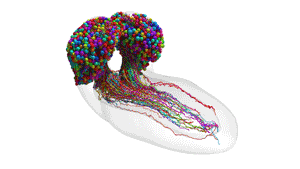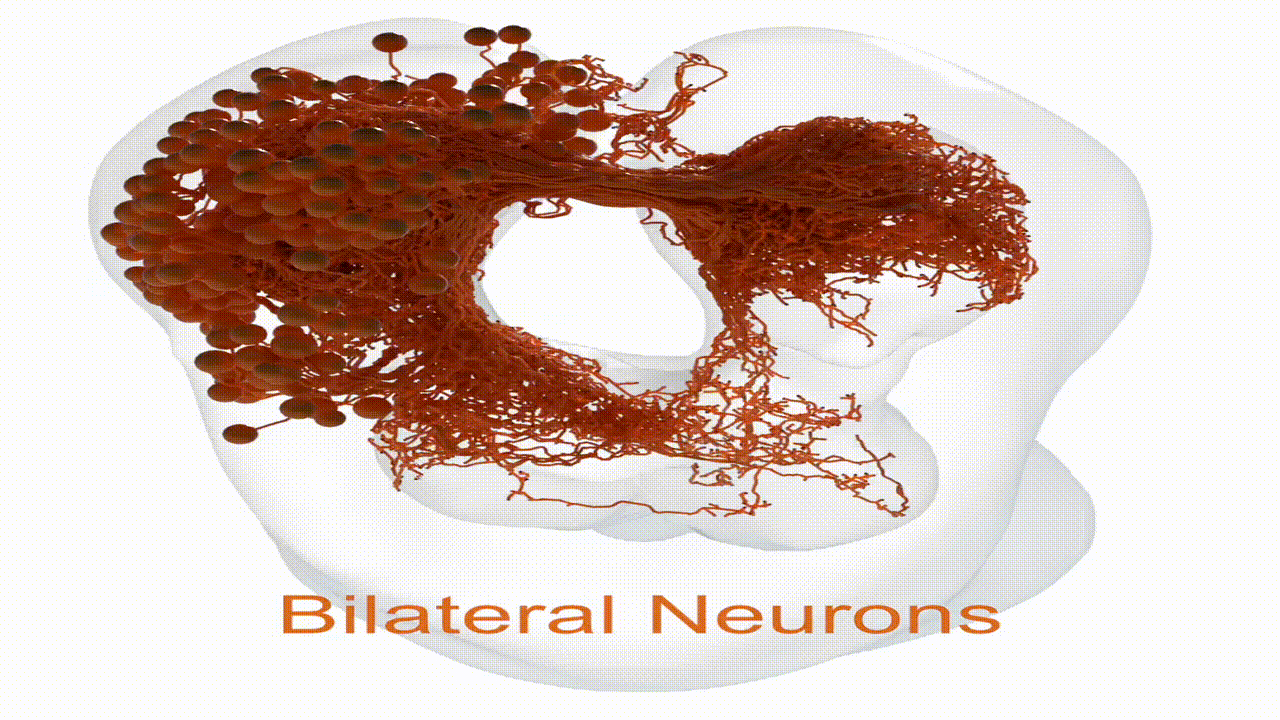To most humans, a fruit fly larva doesn’t look like much: a pale, wriggling, rice grain-shaped maggot, just a few millimetres in length. Yet, in their own way, fly larvae lead rich and interesting lives full of sensory inputs, social behaviours, and learning. If you’ve ever doubted that a lot goes on inside a maggot’s head, now we have the map to prove to it.
An interdisciplinary team of scientists have announced their completion of a full model of a larval fruit fly’s brain. The map, or connectome, as its called in neuroscience, includes each one of the 3,016 neurons and 548,000 of the synapses running between neurons that make up the baby fly’s entire central nervous system. The connectome includes both of the larva’s brain lobes, as well as the nerve cord.

The first (mostly) complete connectome was of a nematode (C. elegans), published in the 1986. To build that initial map, those scientists had to draw out connections by hand using colour pencils. There were 302 neurons and 7,600 synapses and other connections involved.
Since then, a subset of neuroscience has developed that is devoted to the prospect of charting out the brains of increasingly complex organisms. And some big advances have already happened. We’ve gotten entirely complete maps of multiple nematode brains. A relatively low-resolution map of an adult fruit fly brain, that lacks detailed connective analysis, was published in 2018.
In 2020, a multi-institute group, including scientists from Google’s research arm and the Howard Hughes Medical Institute’s Janelia Campus, published a partial connectome of an adult fruit fly’s central brain (25,000 neurons, 20 million connections). A year later, an associated Janelia research team published a followup analysis of that partial adult fly brain, and began to reveal the “why and how” behind the “what.” In that 2021 study, the scientists documented sensory and movement pathways and other complex dynamics that help explain how a fly’s brain enables it to be a fly.
Yet this is the first time scientists have imaged and analysed an entire insect brain at such high resolution. It is the most complete insect brain map ever constructed and the most intricate entire connectome of any animal ever published. In short: it’s a game changer.
For some, it represents a paradigm shift in the field of neuroscience. Fruit flies are model organisms, and many neural structures and pathways are thought to be conserved across evolution. What’s true for maggots might well be true for other insects, mice, or even humans. Researchers will reference this brain in their studies across sub-disciplines, much in the way biologists referred to the first mapped human genome, multiple scientists told Gizmodo. It is more information about an animal’s nervous system, neural pathways, and brain structure than we’ve ever had before. Moreover, the newly published connectome could inform research beyond neuroscience, in fields like artificial intelligence and developmental biology.
“It is a tour de force of how we understand the ways in which brains are connected,” said Timothy Mosca, a neuroscientist studying fruit fly sensory systems at Thomas Jefferson University who was not involved in the new research, in a phone call with Gizmodo.
For decades, we’ve had some of the rough elements of the animal brain mapped. Scientists knew where the motor and sensory neurons generally clustered, Mosca explained. But this new connectome is like going from a blurry satellite view to a crisp city street map. On the block-by-block array of an insect’s cortex, “now we know where every 7-11 and every, you know, Target [store] is,” Mosca said.
To complete the connectome, a group of Cambridge University scientists spent 12 years focusing in on the brain of a single, 6-hour-old female fruit fly larva. The organ, approximately 170 by 160 by 70 micrometres in size, is truly teeny — within an order of magnitude of things too small to see with a naked eye. Yet, the researchers were able to use electron microscopy to visually cut it into thousands of slices, only nanometres thick. Imaging just one of the neurons took a day, on average. From there, once the physical map of the neurons, or “brain volume,” was complete, the analysis began.
Along with computer scientists at Johns Hopkins University, the Cambridge neuroscientists assessed and categorised the neurons and synapses they’d found. The JHU researchers fine-tuned a computer program for this exact application in order to determine cell and synapse types, patterns within the brain connections, and to chart some function onto the larva connectome — based on previous neuroscience studies of behaviour and sensory systems.
They found many surprises. For one, the larval fly connectome showed numerous neural pathways that zigzagged between hemispheres, demonstrating just how integrated both sides of the brain are and how nuanced signal processing can be, said Michael Winding, one of the study’s lead researchers and a Cambridge University neuroscientist, in a video call. “I never thought anything would look like that,” Winding said.

In some regions, the synapses were also highly recursive, repetitive, and reinforced — particularly and “beautifully” in the areas of the brain thought to drive learning, explained Marta Zlatic, another Cambridge neurobiologist and one of the study’s senior researchers, in a video call.
Fascinatingly, these recurrent structures mapped from an actual brain appear to closely match the architecture of some artificial intelligence models (called residual neural networks), with nested pathways allowing for different levels of complexity, Zlatic noted. Winding echoed this description, calling the layout of the maggot’s learning centre a “Russian doll of connectivity.”
Not only was the revealed neural structure layered, but the neurons themselves appear to be multi-faceted. Sensory cells connected across modalities — visual, smell, and other inputs crossed and interacted en route to output cells, explained Zlatic. “This brain does a huge amount of multi-sensory integration…which is computationally a very powerful thing,” she added.
Then there were the types and relative quantities of cell-to-cell connections. In neuroscience, the classic “canonical” type of synapse runs from an axon to a dendrite. Yet, within the mapped larval fly brain, that only accounted for about two-thirds of the connections, Winding and Zlatic said. Axons linked to axons, dendrites to dendrites, and dendrites to axons. Scientists have known these sorts of connections exist in animal nervous systems, but the scope went far beyond what they expected. “Given the breadth of these connections, they must be important for brain computation,” Winding noted. We just don’t know exactly how.

As exciting as this advance is to the neuroscientists (“I’m so stoked to be doing science right now,” Mosca said), connectomes cannot tell us everything. This is “a snapshot of one moment in time in one animal,” Mosca explained. It fills a massive research gap — for understanding brain development between larval and adult fly stages and animal brain structure more generally, but it is limited.
Having a single clear picture of a fly’s neurons and synapses doesn’t tell us what they all do, how brains change over time, or how brains differ between individuals. We don’t yet have the data to compare male and female fly brains, for instance. Nor to track neural shifts as a fly matures. Putting all of the current connectomes in developmental order would be akin to looking at “a flipbook with a few pages missing,” said Mosca.
Though repeated comparisons to the first complete human genome map kept coming up in conversation, DNA is a relatively static dataset, determined with the first cell in an organism’s development, said Josh Vogelstein, a JHU network scientist and one of the study authors, in a video call. In contrast, “your connectome changes every moment,” he said. Plus, the definitions used in Vogelstein and his colleagues’ analysis (i.e the way they drew the map) are subjective. They defined neurons as nodes and synapses as edges — others might reverse that or declare whole brain regions as nodes, he explained. “There is no uniform answer to what a connectome is, and whatever it is, it changes.”
To parse out all those remaining unknowns, more research is key. Imaging advances over the past few years have made it possible to collect brain volume data much more quickly than when this new study began over a decade ago. Plus, with the computer program developed by Vogelstein and his PhD candidate, Benjamin Pedigo, future analyses can progress much faster — on the order of months to correct the data and hours to process it, as opposed to years, Pedigo and Vogelstein told Gizmodo.
Zlatic intends to use this single larval fly connectome as a jumping-off point to collect many more, and then run comparisons to reveal functional links (e.g., how do faster wiggler’s brains look different?). Winding is starting his own lab group where he’ll begin working to identify circuits in fruit fly brains related to social behaviour. From there, he wants to start manipulating those circuits experimentally and see what happens.
Others are working to map the brains of larger organisms. A complete connectome of an adult fruit fly is well underway at Janelia. Some have aspirations of moving on to animal brains as big and complex as those of mice, though such work is still likely years and years from completion.
For Vogelstein, this signals a step toward being able to truly understand (and even code) consciousness. We’re not there yet, but this larval connectome presents the future possibility of reverse-engineering a complex animal’s brain in computer program form. “Everyone in the world, as far as I know, acknowledges or agrees that you need brains for consciousness,” he said. A map of the brain alone “is not sufficient,” for uncovering the whole mystery of sentience. To be clear, “there’s no way we can simulate a conscious brain just by having this connectome,” he emphasised. But it is a “core and necessary component.”
In Mosca’s view — though he isn’t a connectome researcher — he’s ready to use the new larval research in his own work. “This is really going to give us a lot of outstanding fodder to be able to ask more sophisticated research questions,” he said. Across neuroscience and biology, “the sheer amount of work this will inspire and that this will inform is nearly limitless.”
